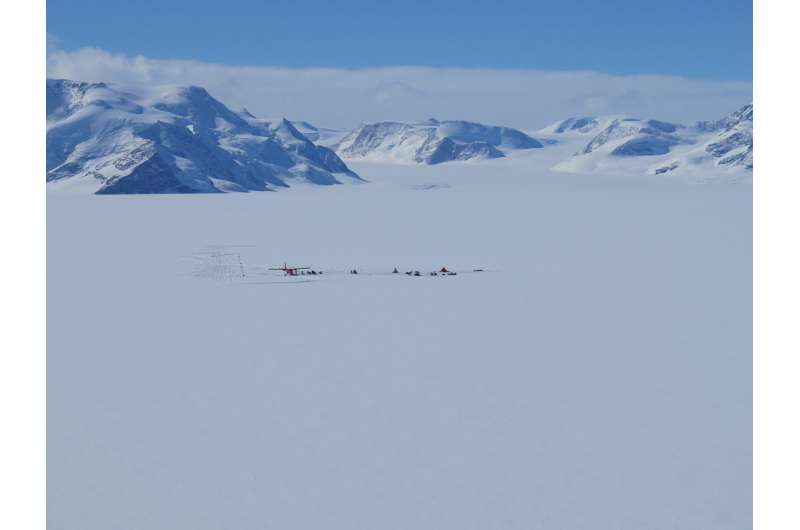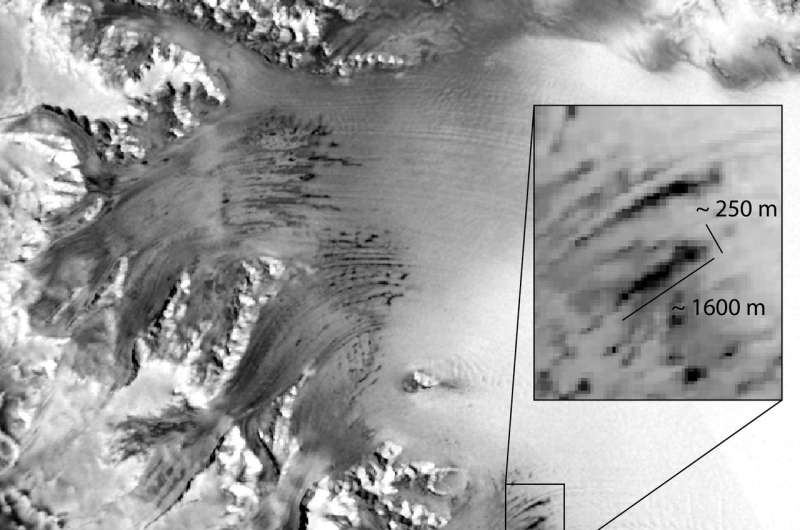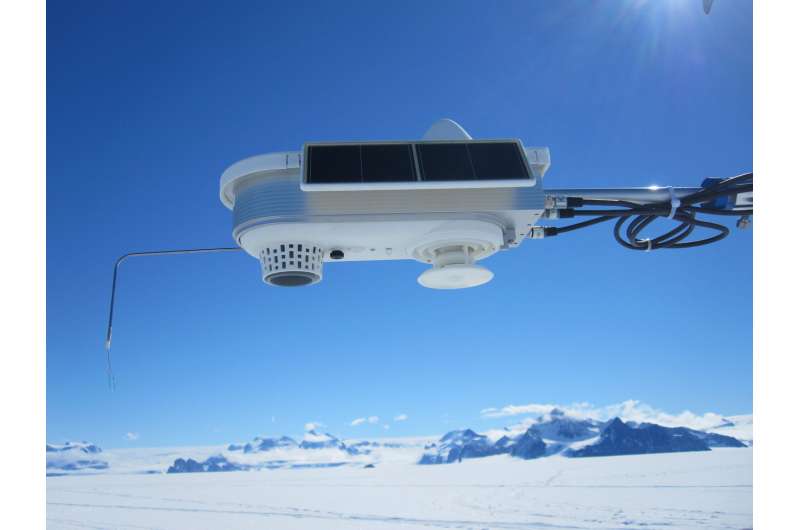Warm wind melts snow in Antarctica in winter as well

Even though the sun does not shine in Antarctica in winter, in some places, snow on the glaciers can melt as a result of warm wind. Utrecht glacier researcher Peter Kuipers Munneke discovered that fact by combining the results of weather stations and satellite images. His findings were published in Geophysical Research Letters on Wednesday 2 May.
Winter in Antarctica is pitch black and freezing cold for months on end. In the interior of the continent, temperatures can drop to -80 Celsius. On the coast, however, the winter is usually a bit milder, around -25 degrees Celsius. It turns out that at those relatively warm spots around the coast, winter temperatures can be even warmer. When the mercury rises above zero, snow begins to melt, causing several meltwater lakes to accumulate on top of the underlying glacier. These lakes can be 50 meters wide, up to a kilometer in length and one or to two meters deep.
No solar heat
Glacier researcher Peter Kuipers Munneke from Utrecht University's (UU) climate institute IMAU was the leader of the study, conducted by researchers from several institutes from the U.K. and the U.S. Kuipers Munneke was surprised by the findings. "The meltwater lakes occur on the Larsen C ice sheet, a large floating glacier in the north of Antarctica, where a large iceberg broke off just last July. We hadn't expected it to melt so much there in the winter, because it's so dark there, and the sun provides absolutely no heat. Four years ago, we installed a weather station there to study why so much snow melts in the area. Unexpectedly, it's due to the melting in the winter, which appears to be caused by the warm wind."

Warm wind
Around once per week, an extremely warm, dry wind blows down from the mountains to the west of the ice sheet. This "foehn wind" can raise the temperature by 15 to 20 degrees in just a few hours. Munneke says, "All of the winter heat comes from the foehn wind, as there is no other heat source this period of year. During a strong foehn, so much snow can melt that it forms huge lakes on the surface of the ice. We had known about these lakes during the summertime, but apparently 20 to 25 percent of the meltwater from the past few years actually occurs in the winter instead."
Munneke was first informed of the high temperatures by a colleague in Swansea, U.K. "In May 2016, I got an email from Adrian Luckman, the co-author of my article. He wondered if it was indeed true that one of our weather stations had given a temperature reading of eight degrees Celsius. At first, I thought that there was something wrong with the instrument, or that it was a value that needed to be corrected for other weather influences that make it seem warmer than it is. But that wasn't the case. It really was that warm."

Munneke was grateful to be able to use satellite images provided by the European Space Agency (ESA). "We observed that large meltwater lakes had developed near the weather station. Just a few years ago, the ESA put new satellites into service that can provide much sharper images, and you can see the meltwater lakes very well on the new images. Before, every pixel on a radar image represented an area of five by five kilometres, but with the new satellites, the resolution is closer to 40 by 40 meters. It's as if you traded the camera on your first mobile phone for the latest iPhone 8."
Thanks to the new radar images, the researchers can also see that the meltwater re-freezes over the course of the winter. Kuipers Munneke: "Both of the times, the lakes developed in May, the start of the Antarctic winter. Later in the season, the water re-froze, creating slabs of ice over those locations. Consequently, the meltwater doesn't flow into the sea, so it doesn't contribute to rising sea levels either."
However, the discovery may have consequences in the future. "Over the past few decades, large floating glaciers have broken off from the Antarctic mainland. That was in some cases caused by the fact that large meltwater lakes had made some of the ice sheets unstable. We may be observing a process that might create meltwater lakes over a much larger area in the future. We expect that there will be many more winter melt days as time passes. Not only because global temperatures are rising, but also because a warmer world means a stronger westerly wind in the southern hemisphere. And that increases the foehn winds that cause winter melting in Antarctica."
The results of glacier researcher Kuipers Munneke form a first insight into winter melt on Antarctica. "Thanks to older satellite images, we already had a good idea of the number of winter melt days since 2000. Only now, by combining the new images and exact temperatures, we understand the consequences. However, it is too short a time frame to know whether it happens more frequently now than in the past. This is an initial study, that we can use to compare the volume of winter melting in the future."
More information: Intense winter surface melt on an Antarctic ice shelf, P. Kuipers Munneke, A. J. Luckman, S. L. Bevan, C. J. P. P. Smeets, E. Gilbert, M. R. van den Broeke, W. Wang, C. Zender, B. Hubbard, D. Ashmore, A. Orr and J. C. King. Geophysical Research Letters online publication, 2 May 2018.
Journal information: Geophysical Research Letters
Provided by Utrecht University Faculty of Science




















